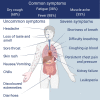JMM Profile: Severe acute respiratory syndrome coronavirus 2 (SARS-CoV-2)
- PMID: 33759741
- PMCID: PMC8346728
- DOI: 10.1099/jmm.0.001336
JMM Profile: Severe acute respiratory syndrome coronavirus 2 (SARS-CoV-2)
Abstract
The severe acute respiratory syndrome coronavirus 2 (SARS-CoV-2) virus is the cause of an infection known as coronavirus infectious disease 2019 (COVID-19). COVID-19 has become a global source of morbidity, mortality and social disruption since its emergence in East Asia in late 2019 and subsequent pandemic spread. Typical symptoms include cough, sore throat, fever, and sudden loss of taste and smell. Persistent, post-infection sequelae have been noted in a minority of cases. Severe complications and deaths occur mostly in older adults. Laboratory confirmation can be performed by viral RNA and antigen detection in nasal swabs or by detecting specific neutralizing antibodies. There is no effective and approved antiviral treatment, but several vaccines with favourable safety and efficacy profiles are being used in mass vaccination programmes. Vaccine-based COVID control should be seen as an addition to existing hygiene measures such as physical distancing, increased hand hygiene, cough etiquette, and barrier protection with personal protective equipment for frontline healthcare workers and other high-risk professions.
Keywords: COVID-19; SARS-CoV-2; virus.
Conflict of interest statement
The authors declare that there are no conflicts of interest.
Figures


Similar articles
-
Lessons learned 1 year after SARS-CoV-2 emergence leading to COVID-19 pandemic.Emerg Microbes Infect. 2021 Dec;10(1):507-535. doi: 10.1080/22221751.2021.1898291. Emerg Microbes Infect. 2021. PMID: 33666147 Free PMC article. Review.
-
COVID-19: breaking down a global health crisis.Ann Clin Microbiol Antimicrob. 2021 May 18;20(1):35. doi: 10.1186/s12941-021-00438-7. Ann Clin Microbiol Antimicrob. 2021. PMID: 34006330 Free PMC article. Review.
-
The British variant of the new coronavirus-19 (Sars-Cov-2) should not create a vaccine problem.J Biol Regul Homeost Agents. 2021 Jan-Feb;35(1):1-4. doi: 10.23812/21-3-E. J Biol Regul Homeost Agents. 2021. PMID: 33377359
-
Human and novel coronavirus infections in children: a review.Paediatr Int Child Health. 2021 Feb;41(1):36-55. doi: 10.1080/20469047.2020.1781356. Epub 2020 Jun 25. Paediatr Int Child Health. 2021. PMID: 32584199 Review.
-
Epidemiology and precision of SARS-CoV-2 detection following lockdown and relaxation measures.J Med Virol. 2021 Apr;93(4):2374-2384. doi: 10.1002/jmv.26731. Epub 2020 Dec 29. J Med Virol. 2021. PMID: 33314153
Cited by
-
JMM Profiles for the Journal of Medical Microbiology: an update.J Med Microbiol. 2022 Mar;71(3):001515. doi: 10.1099/jmm.0.001515. J Med Microbiol. 2022. PMID: 35262475 Free PMC article. No abstract available.
-
The importance of physical activity in management of type 2 diabetes and COVID-19.Ther Adv Endocrinol Metab. 2021 Oct 26;12:20420188211054686. doi: 10.1177/20420188211054686. eCollection 2021. Ther Adv Endocrinol Metab. 2021. PMID: 34721838 Free PMC article. Review.
-
Introducing JMM Profiles for the Journal of Medical Microbiology.J Med Microbiol. 2021 Mar;70(3):001296. doi: 10.1099/jmm.0.001296. Epub 2021 Mar 23. J Med Microbiol. 2021. PMID: 33759740 Free PMC article. No abstract available.
References
-
- World Health Organization COVID-19 website. https://www.who.int/emergencies/diseases/novel-coronavirus-2019
-
- World Health Organization Laboratory biosafety guidance related to coronavirus disease 2019 (COVID-19). Interim Guidance. https://www.who.int/publications/i/item/laboratorybiosafety-guidance-rel...
-
- European Centre for Disease Prevention and Control COVID-19 pandemic. https://www.ecdc.europa.eu/en/covid-19-pandemic
-
- CDNA Coronavirus Disease 2019 (COVID-19) CDNA National Guidelines for public health units. https://www1.health.gov.au/internet/main/publishing.nsf/Content/cdna-son...
Publication types
MeSH terms
LinkOut - more resources
Full Text Sources
Other Literature Sources
Medical
Miscellaneous

